Hogan is a globally recognised provider of pre-employment assessments, widely used to evaluate personality, cognitive ability, and leadership potential.
While no test guarantees workplace success, the Hogan Assessment is trusted across industries for its rigorous evaluation of candidates, measuring strengths, risks, and reasoning skills.
This page offers a free Hogan test online, featuring Hogan assessment sample questions from all four key tests:
- Hogan Personality Inventory (HPI) – 206 personality test questions
- Hogan Development Survey (HDS) – 168 questions assessing career risks
- Hogan Motives, Values, and Preferences Inventory (MVPI) – 200 workplace motivation questions
- Hogan Business Reasoning Inventory (HBRI) – 24 cognitive ability test questions
You’ll find 5 free Hogan test practice questions per assessment, with detailed explanations from our Hogan test prep experts—20 questions and answers in total to help you succeed.

What is the Hogan Assessment?
The Hogan Assessment is a widely used pre-employment test designed to evaluate personality, cognitive ability, leadership potential, and workplace behaviour. It consists of several key assessments:
- Hogan Personality Inventory (HPI) – Measures strengths, work style, and behavioural tendencies.
- Hogan Business Reasoning Inventory (HBRI) – Assesses cognitive ability and problem-solving skills.
- Hogan Emotional Intelligence Assessment – Evaluates interpersonal awareness and emotional regulation.
Employers rely on these tests to predict job performance, leadership potential, and workplace fit.
Free Hogan Assessment Practice Test
Prepare for your Hogan test with our free Hogan assessment practice questions. This test includes:
- Hogan test sample questions from all four assessments.
- Hogan test practice questions with detailed explanations from experts.
- Insights into Hogan personality test questions and Hogan cognitive ability test format.
Practising with these Hogan assessment sample questions will help you familiarise yourself with the structure and improve your performance.
Free Hogan Personality Inventory (HPI) Sample
The Hogan Personality Inventory (HPI) test includes 206 personality test questions, each linked to one of seven key personality traits. To succeed, you must identify which Hogan Personality Inventory trait each statement evaluates and determine the optimal personality profile for the role you’re applying for. Understanding these Hogan test personality factors is essential for achieving a high score on the Hogan Assessment.
I am a calm and unstressed individual
Strongly Disagree
Disagree
Agree
Strongly Agree
Answer #1: This statement assesses the Adjustment trait.
When answering this question, you should consider whether agreeing with the statement demonstrates a positive attribute towards the trait. In this case, the statement expresses calmness, which is a positive attribute of a leader or a general role. Therefore, the statement is positive when considering the Adjustment trait and should be answered as Strongly Agree or Agree.
I regularly stay until the end when at parties
Strongly Disagree
Disagree
Agree
Strongly Agree
Answer #2: This statement assesses the Sociability trait.
When answering this question, you should consider whether agreeing to it demonstrates a positive attribute towards the trait. In this case, the statement expresses an open, friendly, and amicable attitude, which is a positive attribute of a leader or a general role. Therefore, the statement is positive when considering the Sociability trait and should be answered as Strongly Agree or Agree.
I am more comfortable working with data than with people
Strongly Disagree
Disagree
Agree
Strongly Agree
Answer #3: This statement assesses the Interpersonal Sensitivity trait.
When answering this question, you should consider whether agreeing to it demonstrates a positive attribute towards the trait. In this case, the statement expresses an unapproachable attitude that implies a lack of teamwork, which is a negative attribute of a leader or a general role. The test focuses on personality skills such as leadership and social skills, not your ability to analyze data. Therefore, the statement is negative when considering the Interpersonal Sensitivity trait and should be answered as Strongly Disagree or Disagree.
I am constantly in heated discussions with others
Strongly Disagree
Disagree
Agree
Strongly Agree
Answer #4: This statement assesses the Prudence trait.
In this case, the statement expresses an aggressive and unpleasant character, which is a negative attribute of a leader or a general role. The word constantly should be addressed here – and an employee who will always be easily aggregated is not desirable. Therefore, the statement is negative when considering the Prudence trait and should be answered as Strongly Disagree or Disagree.
Solving riddles gives me pleasure
Strongly Disagree
Disagree
Agree
Strongly Agree
Answer #5: This statement assesses the Inquisitive trait.
In this case, the statement expresses an intrigued, curious, and aspiring attitude, which is a positive attribute of a leader or a general role. Therefore, the statement is positive when considering the Inquisitive trait and should be answered as Strongly Agree or Agree.
The best way to prepare for the HPI test is first to practice many statements and learn to identify which of the seven core traits is measured: adjustment, ambition, sociability, interpersonal sensitivity, prudence, inquisitiveness, or learning approach.
Find Hogan Personality Inventory (HPI) study guides and a full HPI test with explanations in our Hogan PrepPack. Learn how to optimise your Hogan test score while avoiding responses that exceed the ideal personality range.
The HPI test assesses positive traits linked to strong employees and leaders. But what about problematic personality traits that, if too extreme, could derail success? The Hogan Development Survey (HDS) addresses this in 168 questions, evaluating the dark side of personality with less straightforward attributes and responses. Try our HDS practice questions to prepare.
For additional HPI examples and more tips on how to choose the right answers for your job, go to our designated Hogan HPI page.
Master the Hogan Personality Test with Guided Practice
Avoid guesswork—practise Hogan Personality Inventory (HPI) test questions with full simulations and expert insights. Learn how to align your trait scores with employer expectations and improve with professional analysis.
Free Hogan Development Survey (HDS) Sample
The Hogan Development Survey (HDS) test consists of 168 personality test questions, each assessing one of 11 key traits. It evaluates potential career derailers, including negative traits like Skeptical, Mischievous, and Excitable, where lower scores are ideal, and neutral traits like Diligent, Colorful, and Bold, where an optimal mid-range score is expected. Understanding these Hogan personality risk factors is essential for excelling in the Hogan Assessment.
Most of the time, I do what my manager tells me to, despite my own opinions
Strongly Disagree
Disagree
Agree
Strongly Agree
Answer #6: This statement assesses the Dutiful trait.
When answering this question, you should consider whether agreeing to it demonstrates a positive attribute towards the trait. In this case, the statement expresses an obedient, hierarchy-oriented, yet non-independent attitude, which is mostly negative for leadership roles while somewhat positive for general employees. Therefore, the statement is positive when considering the Dutiful trait. Leaders should answer Strongly Disagree or Disagree, and general employees should answer Agree.
If I weren’t disrupted so much during my work, I would be more successful at it
Strongly Disagree
Disagree
Agree
Strongly Agree
Answer #7: This statement assesses the Leisurely trait.
In this case, the statement expresses an easily irritated and stressed person, which is negative for leadership roles and general employees. Therefore, the statement is positive when considering the Leisurely trait and should be answered as Strongly Disagree or Disagree.
The problems of others usually bother me
Strongly Disagree
Disagree
Agree
Strongly Agree
Answer #8: This statement assesses the Reserved trait.
In this case, the statement expresses an engaging and caring person, which is positive for leadership roles and general employees. Therefore, the statement is negative when considering the Reserved trait and should be answered as Strongly Agree or Agree.
There is almost always a self-serving reason behind a person doing a service for you
Strongly Disagree
Disagree
Agree
Strongly Agree
Answer #9: This statement assesses the Skeptical trait.
In this case, the statement expresses a pessimistic attitude, which is negative for leadership roles and general employees. Therefore, the statement is positive when considering the Skeptical trait and should be answered as Strongly Disagree or Disagree.
I enjoy having everyone's attention on me
Strongly Disagree
Disagree
Agree
Strongly Agree
Answer #10: This statement assesses the Colorful trait.
In this case, the statement expresses a social, eccentric, yet self-centred attitude, which is questionable for both leadership roles and general employees. Therefore, the statement is positive when considering the Colorful trait and should be answered as Disagree.
Note: unlike the HPI, where the traits were all positive, and the objective was to identify the connection between the statements and traits while maintaining the score on the range for each statement – the HDS test is more complex. You have noticed that a few of the questions included “neutral” traits – meaning the range is at the centre of the scale. Maintaining a “neutral” score is far more challenging as you should demonstrate an ambivalent resemblance to a specific trait – meaning you should locate the traits of a specific trait and answer according to previous responses.
Hogan Motives, Values, and Preferences Inventory (MVPI)
The Hogan Motives, Values, and Preferences Inventory (MVPI) is a 200-question personality assessment designed to evaluate what drives workplace motivation and career success. Unlike the Hogan Personality Inventory (HPI) and Hogan Development Survey (HDS), which assess personality traits, the MVPI test focuses on core values, interests, and long-term goals. Employers use it to determine job fit, leadership potential, and whether a candidate aligns with a company’s culture and vision. Understanding your MVPI profile can help you identify the right career path, work environment, and role for long-term success.
The humanities are the principle of all culture
Disagree
Agree
Uncertain
Answer #11: This statement assesses the Aesthetic trait.
When answering this question, you should consider whether agreeing to it demonstrates a positive attribute towards the trait. In this case, the statement expresses a creative, visually oriented individual, and therefore it is positive when concerning the Aesthetic trait.
For business positions, this statement is “Neutral” as business/scientific positions can have a large range of medium scores for the Aesthetic trait. Still, for this statement, the answer should be Agree.
For aesthetic positions, this statement is positive, as creative/designer positions should have a high score for the Aesthetic trait. Therefore, the answer should be Agree.
The universe’s unknowns are concrete and learnable
Disagree
Agree
Uncertain
Answer #13: This statement assesses the Scientific trait.
In this case, the statement expresses a realistic and curious individual, and therefore it is positive when concerning the Scientific trait.
For business positions, this statement is positive as business/scientific positions should have a high score for the Scientific trait. Therefore, the answer should be Agree.
For aesthetic positions, this statement is “Neutral” as business/scientific positions can have a large range of medium scores for the Scientific trait. Still, for this statement, the answer should be Agree.
I would like it more if I were to work independently
Disagree
Agree
Uncertain
Answer #13: This statement assesses the Affiliation trait.
In this case, the statement expresses a self-oriented and individualistic attitude, and therefore it is negative when concerning the Affiliation trait.
For manager positions, this statement is negative as leaders work in teams, lead their employees, and should inspire teamwork. Therefore, the answer should be Disagree.
For general positions, this statement is “Neutral” as universal employee positions vary between individual roles and part of a team. Still, for this statement, the answer should be Disagree.
People who prefer to focus on labour over fun are uninteresting
Disagree
Agree
Uncertain
Answer #14: This statement assesses the Hedonistic trait.
In this case, the statement expresses a social attitude, while it may be lacking motivation for hard work, and therefore it is positive when concerning the Hedonistic trait.
For business positions, this statement is negative as business/scientific positions require hard work, thoroughness, and dedication which may sometimes overcome recreational activities. Therefore, the answer should be Disagree.
For aesthetic positions, this statement, while being more positive, as creative/designer positions are characterized by an open mind and a free spirit – is still negative for all workers since it shows a lack of work ethics. Therefore, the answer should be Disagree.
It is preferable to be in charge than to be a subordinate
Disagree
Agree
Uncertain
Answer #15: This statement assesses the Power trait.
In this case, the statement expresses a strive to be a leader and take responsibility. In contrast, it may express not accepting authority, and therefore it is positive when concerning the Power trait.
For manager positions, this statement is positive, as leaders should strive to be in charge and take responsibility. It is exceptionally important for business managers since they usually work in a stricter hierarchy. Therefore, the answer should be Agree.
For general positions, this statement is mostly positive but can also be neutral. Employers are looking for strong, confident employees who will take further responsibilities for themselves, however, to an extent. Therefore, the answer should be Disagree.
How to Prepare for the Hogan Assessment Test
The best way to succeed in the Hogan Assessment is with structured practice:
- Practise Hogan Personality Test Questions – Start with HPI and HDS sample questions to identify assessed traits.
- Learn the Optimal Trait Range – Understand how to balance responses for your specific role.
- Avoid Extreme Answers – The test detects inconsistencies, so aim for authentic, well-rounded responses.
- Use Expert Feedback – Our Hogan Preparation Pack includes full HPI and HDS simulations with detailed explanations to help you improve.
★ 4.8 (14 reviews) | 2000+ already enrolled
Congratulations!
You have successfully completed the personality portion of our Free Hogan Test. However, the test is not over, and after assessing your personal traits, you will now face the cognitive portion of the Hogan assessment – the HBRI (Hogan Business Reasoning Inventory) test. The HBRI test includes graphs and tables, reading comprehension, and reasoning questions – all of which refer to different aspects of general businesses’ daily work.
Hogan Business Reasoning Inventory (HBRI)
The Hogan Business Reasoning Inventory (HBRI) test consists of 24 cognitive ability test questions, assessing problem-solving, decision-making, and analytical skills. It evaluates how candidates process numerical, verbal, and abstract information to solve business challenges. The test measures both quantitative reasoning, where accuracy is key, and qualitative reasoning, which assesses logical thinking. Excelling in the HBRI test requires strong critical thinking and business reasoning skills, making Hogan cognitive ability test practice essential for success.

Choose the correct answer:
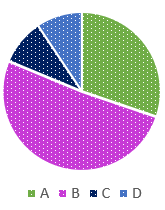
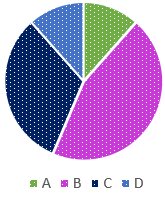

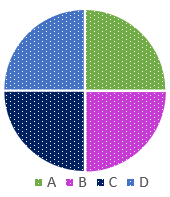
Answer #16:
The correct answer is:

(Leftmost answer)
In this question, you are presented with a pair of charts and asked to find which of the answer options creates an equivalent pair with the chart on the right. This means the relationship between the missing pie chart to the bar chart on the right has to be the same as the relationship between the pie chart and the bar chart in the given pair.
Notice that both of these charts represent the same information. Even though there are no specific numbers in the pie charts to make sure, all parameters (A, B, C, and D) are the same in relation to one another in both charts. For example, in both, D is the largest and C is the smallest.
A good way to solve this question is to find in the chart a prominent feature and look for the same feature in the possible answers. For example, in this case, C and D in the bar chart are identical and significantly smaller than the other bars in the charts. The only pie charts in which there are two identical and significantly smaller sections are A and B, and only in A those sections are labelled C and D.
Based on the previous years, what would be the best estimate for the 2018 total company's income?
140,742
140,760
138,736
140,700
Answer #17:
The correct answer is (A) - 140,742.
To solve this question, you have to calculate the change in percentage between years according to the formula:

According to the pattern, from 2017 to 2018 the total income will rise by ~5.2%.
💡 Another way of calculating the change in percentage between years is using the formula:
To calculate the total income of 2018, use the formula:

Therefore, the total income of 2018 would be estimated at:

answer the question below based on this passage
Previous research established that “financial socialization” is the process through which children learn about finance, mainly from their parents. Most of the research concerning this process focuses on two aspects: the example parents set, and what they directly teach their children about money.
A new study suggests that a third aspect is no less important: the practical experience parents provide their children with money. There are various ways parents can give their children this practical experience: by giving them a regular allowance, by paying them for performing tasks that go beyond their regular chores, by offering cash rewards for good grades, or by encouraging them to save for a special purchase or a charitable donation. Some or all of these can be applied simultaneously, of course. The amount of money is not important – what matters is that the kids will have practical experience with money while the stakes are still low.
The researcher stresses the importance of gaining experience with money while the stakes are low, and while the children are under their parents’ guidance. If a person has to deal with money for the first time when alone, and the stakes are high (saving up for a house, paying bills, and managing daily expenses, for example), much more expensive and fateful mistakes might be made. The same mistakes can be made when the stakes are low, when the child can learn from them, and later in life, when alone and the sums are high, the child will avoid those same mistakes because they have practice and experience.
Adapted from: 'Parents: To prepare kids financially, give them practice with money' published on Science Daily. Source
Which of the following is not presented as ways parents can teach their children about money?
Rewarding them for good behaviour towards their siblings.
Giving them a regular allowance.
Offering cash rewards for good grades
Encouraging them to save for a special purchase or charitable donation.
Only (A), “rewarding them for good behaviour towards their siblings”, is not mentioned in the text.
All of the other options are mentioned in the second paragraph as strategies parents can employ to teach their children about money management.
This kind of question requires you to read quickly, and more importantly, that you find the relevant information quickly.
A good strategy is to first read the question and try to pick up a few keywords to quickly find in the text so you won’t have to read it in its entirety since it is mostly irrelevant.
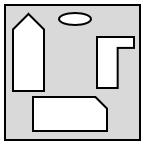
Choose the correct answer:
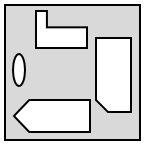
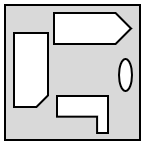
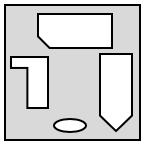
Answer #19:
The correct answer is:

(centre answer)
This question requires mentally rotating a chart consisting of multiple shapes. On this type of question, it is helpful to focus on one of the shapes and examine it separately.
To demonstrate how focusing on a single feature of the visual can help you solve the question, let us focus on the L shape.
In the original chart, it is located on the right side, and its thin arm is close to the ellipse and is pointing right. Now, carefully examine what happens when the chart rotates:
If you turn the chart 90° clockwise, the L shape moves to the bottom of the chart, and its thin arm is still close to the ellipse and points down. This is what happens in Chart B.

If you turn the chart another 90° clockwise, the L shape moves to the left side of the chart, and its thin arm is still close to the ellipse and points left. In chart C, the L shape is located on the left side and its thin arm is pointing left, but it is not close to the ellipse, so this option should be eliminated
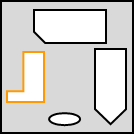
If you turn the chart yet another 90° clockwise, The L shape is identical to chart A: The L shape moves to the top of the chart, and its thin arm is still close to the ellipse and points up.
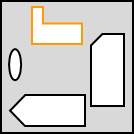
The correct answer is either A or B. To decide between the two, select another salient feature such as the rectangle with the trimmed corner, and examine what happens to it as the chart rotates. In the original chart, it is located at the bottom of the chart and its trimmed corner is adjacent to the L shape.
If you turn the chart 90° clockwise, the rectangle moves to the left side of the chart and its trimmed corner is still adjacent to the L shape. This is what happens in chart (B).

If you turn the chart another 90° clockwise, the rectangle moves to the top of the chart and its trimmed corner is still adjacent to the L shape.
If you turn the chart yet another 90° clockwise, the rectangle moves to the right side of the chart and its trimmed corner is still adjacent to the L shape. In chart (A), the rectangle is located on the right side of the chart but is not adjacent to the L shape, so this option should be eliminated.
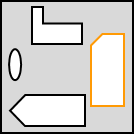
💡 Another method of resolution is to describe the shape in words. You can say that the thick arm of the L shape is adjacent to the trimmed corner of the rectangle. Then, you can check which of the answer options matches this description. Only option (A) accurately matches the description, which makes it the correct answer. In option A the thick arm of the L shape is adjacent to a “full” corner of the rectangle. In option C it is the thin arm of the L shape that is adjacent to the trimmed corner of the rectangle.
The company you work for is designing new ads. All the new ads must be approved by the board. If some of the new ads are turning a profit for the company, which of the following must be true?
All ads approved by the board are turning a profit.
Some of the ads approved by the board are causing losses.
None of the ads approved by the board are turning a profit.
Some of the ads approved by the board are turning a profit.
Answer #20:
The correct answer is (D).
Answer (D) is the correct answer because it is the only one that must be true. Since all new ads must be approved by the board, it follows that the new ads that are turning a profit were also approved by the board. Therefore, it is true that some of the ads approved by the board are turning a profit.
Answer (A) is incorrect since the question states that only some of the new ads are turning a profit, not necessarily all.
Answer (B) is incorrect since the question requires that the answer must be true. While it is possible, realistically, that some of the ads are causing losses, we cannot know that from the presented information. The sentence “some of the new ads are turning a profit” does not necessarily mean that the opposite is also true (that some of the new ads are causing losses). It may be that the other ads are breaking even, or that all of them are turning a profit (since "some" means at least one, possibly all); there is not enough information to know. Since it is impossible to know for certain, the requirement to pick a statement that must be true, beyond a doubt, is not met.
Answer (C) is incorrect since the question clearly states that some of the ads are turning a profit, meaning it cannot be true that none of them is profitable.
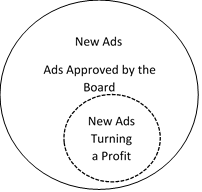
Congratulations on Finishing the Test! Ready to Boost Your Hogan Test Score?
You’ve completed our free Hogan test online—now it’s time to take your preparation to the next level. Master the Hogan Personality Inventory (HPI), Hogan Development Survey (HDS), and Hogan Business Reasoning Inventory (HBRI) with full-length simulations, expert solving techniques, and in-depth trait analysis. Without structured practice, achieving a high Hogan test score is challenging.
For just £39, access our comprehensive Hogan PrepPack, featuring detailed guides, unique solving strategies, and full practice tests—giving you the best chance to succeed in the real Hogan Assessment.
Master the Hogan Assessment with Expert Practice
The Hogan Business Reasoning Inventory (HBRI) is tougher than standard cognitive ability tests, assessing numerical, verbal, and mechanical reasoning at a higher difficulty level. With the right Hogan test prep, you can boost your score and reduce test anxiety.
JobTestPrep’s All-Inclusive Hogan PrepPack™ provides:
Full-length HPI, HDS, and MVPI simulations
- 5 full HBRI simulation tests
- Comprehensive personality study guides
- Additional cognitive practice tests
- Video tutorials and expert techniques
Get the most effective Hogan test practice and ensure success with JobTestPrep’s expert-designed PrepPack™.
★ 4.8 (14 reviews) | 2000+ already enrolled
Related Tests
Create Your Custom Assessment Prep Kit
Job-seeking can be a long and frustrating process, often taking months and involving numerous pre-employment tests and interviews. To guide you through it, we offer a Premium Membership.



